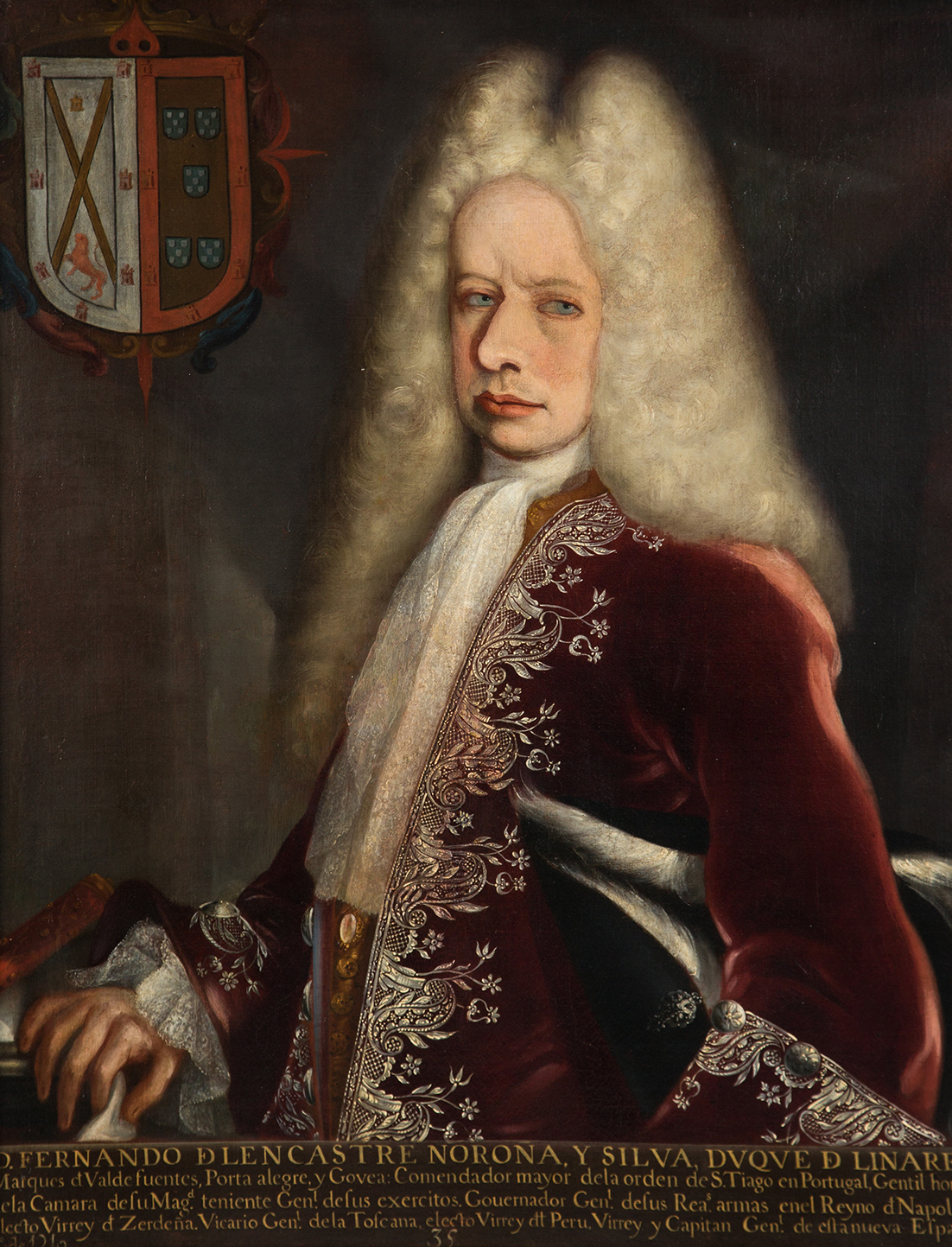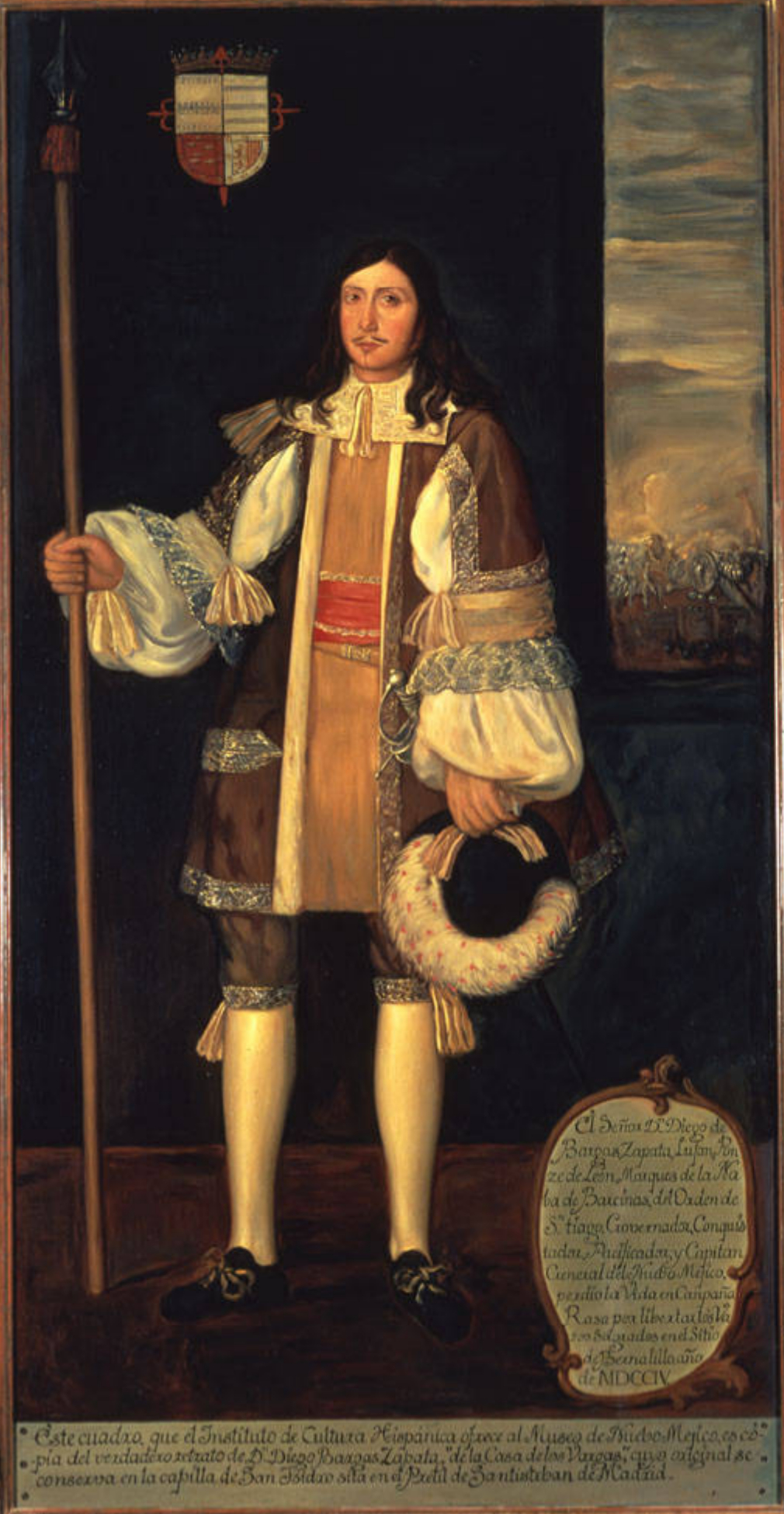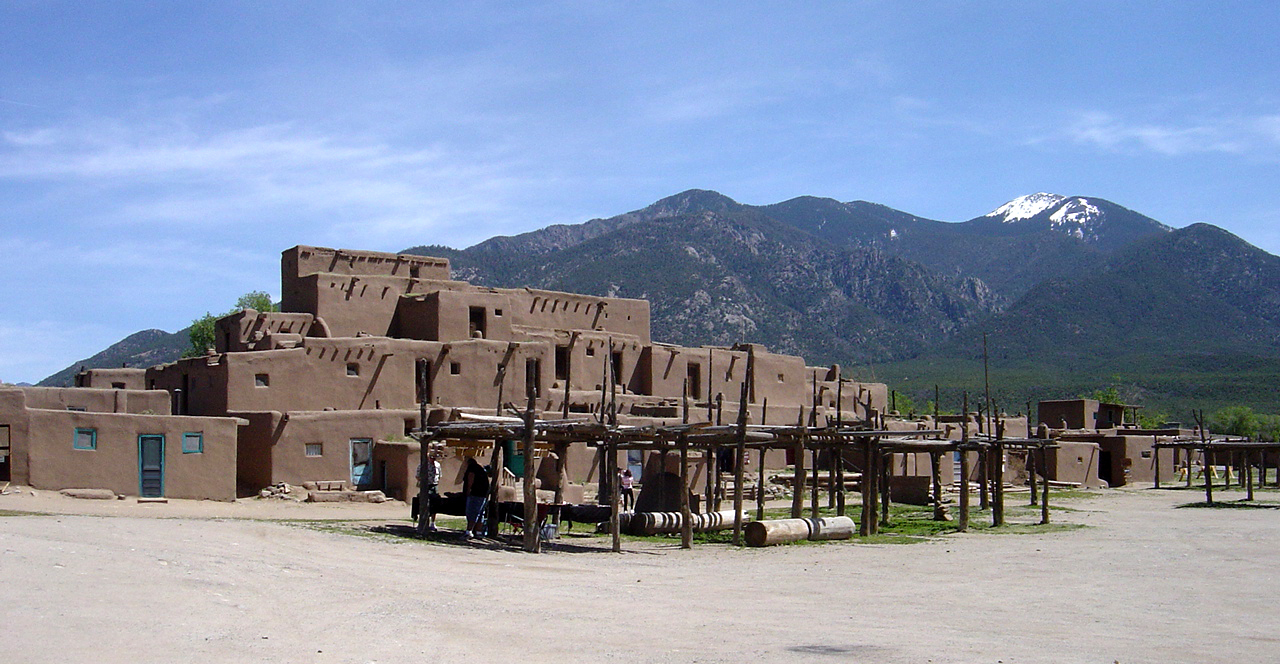|
José Naranjo (scout)
José Naranjo ( – 14 August 1720) was a Puebloan of partial African ancestry who served the Spanish government of New Mexico. His father may have helped lead the Pueblo Revolt of 1680 and Naranjo initially opposed co-operation with the Spanish, successfully escaping from Spanish custody. After 7 October 1692, Naranjo appears to have come to terms with the Spanish, working for the governor of New Mexico Diego de Vargas. Shortly afterwards Naranjo killed his brother Lucas, who was leading an Indian rebellion, and sent his head to Vargas. Naranjo was appointed an alcalde and leader of Indian auxiliary troops, serving on expeditions against the Apache and the Pueblo who had fled to El Cuartelejo. In 1720 he was appointed chief scout and leader of auxiliary troops on the Villasur expedition, despite having opposed it. He was killed on 14 August 1720 when the expedition was attacked by Pawnee and Otoe forces. Early life Naranjo was a Pueblo Indian born circa 1662 to Domingo Naran ... [...More Info...] [...Related Items...] OR: [Wikipedia] [Google] [Baidu] |
Columbus, Nebraska
Columbus is a city in and the county seat of Platte County, in the state of Nebraska in the Midwestern United States. The population was 22,111 at the 2010 census. It is the 10th largest city in Nebraska, with 24,028 people as of the 2020 census. History Pre-settlement In the 18th century, the area around the confluence of the Platte and the Loup Rivers was used by a variety of Native American tribes, including Pawnee, Otoe, Ponca, and Omaha. The Pawnee are thought to have descended from the Protohistoric Lower Loup Culture; the Otoe had moved from central Iowa into the lower Platte Valley in the early 18th century; and the closely related Omaha and Ponca had moved from the vicinity of the Ohio River mouth, settling along the Missouri by the mid-18th century. In 1720, Pawnee and Otoe allied with the French massacred the Spanish force led by Pedro de Villasur just south of the present site of Columbus. In the 19th century, the "Great Platte River Road"—the valley of ... [...More Info...] [...Related Items...] OR: [Wikipedia] [Google] [Baidu] |
Mestizo
(; ; fem. ) is a term used for racial classification to refer to a person of mixed Ethnic groups in Europe, European and Indigenous peoples of the Americas, Indigenous American ancestry. In certain regions such as Latin America, it may also refer to people who are culturally European even though their ancestors are not. The term was used as an ethnic/racial category for mixed-race that evolved during the Spanish Empire. Although, broadly speaking, means someone of mixed European/Indigenous heritage, the term did not have a fixed meaning in the colonial period. It was a formal label for individuals in official documents, such as censuses, parish registers, Inquisition trials, and others. Priests and royal officials might have classified persons as mestizos, but individuals also used the term in self-identification. The noun , derived from the adjective , is a term for racial mixing that did not come into usage until the twentieth century; it was not a colonial-era term.Rappap ... [...More Info...] [...Related Items...] OR: [Wikipedia] [Google] [Baidu] |
Navajo
The Navajo (; British English: Navaho; nv, Diné or ') are a Native American people of the Southwestern United States. With more than 399,494 enrolled tribal members , the Navajo Nation is the largest federally recognized tribe in the United States; additionally, the Navajo Nation has the largest reservation in the country. The reservation straddles the Four Corners region and covers more than 27,325 square miles (70,000 square km) of land in Arizona, Utah, and New Mexico. The Navajo Reservation is slightly larger than the state of West Virginia. The Navajo language is spoken throughout the region, and most Navajos also speak English. The states with the largest Navajo populations are Arizona (140,263) and New Mexico (108,306). More than three-fourths of the enrolled Navajo population resides in these two states. [...More Info...] [...Related Items...] OR: [Wikipedia] [Google] [Baidu] |
Fernando De Alencastre, 1st Duke Of Linares
Fernando de Alencastre Noroña y Silva, 1st Duke of Linares, GE (April 15, 1662 in Madrid, Spain – June 3, 1717 in Mexico City) was a Spanish nobleman and military officer. He also served as Viceroy of New Spain (colonial México), from January 15, 1711 to August 15, 1716. Early career Alencastre Noroña y Silva was a descendant of Fernando de Noroña, Duke of Linares, and thus from a distinguished Spanish family with origins in the Portuguese nobility. In addition to the two titles he inherited, he was knight commander of the Order of Santiago, lord of the bedchamber of the king, and lieutenant general in the army. He was also knight commander of the royal arms in the Kingdom of Naples, honorary viceroy of Sardinia, and vicar general of La Toscana. Alencastre was an early donor to the Jesuit missions in Baja California, providing 5,000 reales as seed money in 1697. Viceroy of New Spain In 1711 Fernando de Alencastre became the colonial viceroy and captain general of the V ... [...More Info...] [...Related Items...] OR: [Wikipedia] [Google] [Baidu] |
Juan De Ulibarrí
Juan de Ulibarrí or Uribarrí (1670-1716) was a Spanish or Criollo soldier and explorer who lived in New Mexico. In 1706 he led an expedition to El Cuartelejo on the Great Plains of western Kansas and eastern Colorado. Ulibarrí's diary survives and is an important source for the history of Spanish exploration of the Great Plains and relationships with the Apache and Pueblo Indians. The purpose of Ulibarrí's expedition was to find and escort back to New Mexico about 60 people from Picuris Pueblo who had earlier fled Spanish rule in New Mexico and established communities on the Great Plains. The Cuartelejo Ruins in Kansas are a remnant of the Pueblos who lived on the plains. Early life According to genealogical research, Ulibarrí (also known as Juan de los Reyes) was born in San Luis Potosi, Mexico and baptized there on March 8, 1670. His parents were Jose Enriquez de los Reyes and Maria Hernandez Ynojos. He had a brother named Antonio and both came to New Mexico with Dieg ... [...More Info...] [...Related Items...] OR: [Wikipedia] [Google] [Baidu] |
Apache Language
Southern Athabaskan (also Apachean) is a subfamily of Athabaskan languages spoken primarily in the Southwestern United States (including Arizona, New Mexico, Colorado, and Utah) with two outliers in Oklahoma and Texas. The language is spoken to a much lesser degree in the northern Mexican states of Sonora, Chihuahua, Durango, Coahuila, and Nuevo León. Those languages are spoken by various groups of Apache and Navajo peoples. Elsewhere, Athabaskan is spoken by many indigenous groups of peoples in Alaska, Canada, Oregon and northern California. Self-designations for Western Apache and Navajo are ''Nnee biyáti’'' or ''Ndee biyáti’,'' and or , respectively. There are several well-known historical people whose first language was Southern Athabaskan. Geronimo (Goyaałé) who spoke Chiricahua was a famous raider and war leader. Manuelito spoke Navajo and is famous for his leadership during and after the Long Walk of the Navajo. Family division The seven Southern Athabaskan la ... [...More Info...] [...Related Items...] OR: [Wikipedia] [Google] [Baidu] |
Bernalillo, New Mexico
Bernalillo () is a town in Sandoval County, New Mexico, Sandoval County, New Mexico, United States. As of the United States Census, 2010, 2010 census, the town population was 8,320. It is the county seat of Sandoval County, New Mexico, Sandoval County. Bernalillo is part of the Albuquerque, New Mexico, Albuquerque Albuquerque metropolitan area, Metropolitan Statistical Area. History Wine Festival In the 1620s, the wine grape was introduced to Bernalillo and the wine industry blew up. Families were making their own wine from scratch and vineyards were flourishing. Unfortunately, the market dipped due to drought and floods. Slowly over time, the wine industry came back into Bernalillo and has sustained its health today, becoming a tradition and staple within the town itself. The town has embraced its wine heritage and hosts the New Mexico Wine festival yearly during each Labor Day. The event brings in people from all of New Mexico as well as tourists. The event has served as an ... [...More Info...] [...Related Items...] OR: [Wikipedia] [Google] [Baidu] |
Santa Fe, New Mexico
Santa Fe ( ; , Spanish for 'Holy Faith'; tew, Oghá P'o'oge, Tewa for 'white shell water place'; tiw, Hulp'ó'ona, label=Tiwa language, Northern Tiwa; nv, Yootó, Navajo for 'bead + water place') is the capital of the U.S. state of New Mexico. The name “Santa Fe” means 'Holy Faith' in Spanish, and the city's full name as founded remains ('The Royal Town of the Holy Faith of Saint Francis of Assisi'). With a population of 87,505 at the 2020 United States census, 2020 census, it is the List of municipalities in New Mexico, fourth-largest city in New Mexico. It is also the county seat of Santa Fe County. Its metropolitan area is part of the Albuquerque, New Mexico, Albuquerque–Santa Fe–Las Vegas, New Mexico, Las Vegas Albuquerque–Santa Fe–Las Vegas combined statistical area, combined statistical area, which had a population of 1,162,523 in 2020. Human settlement dates back thousands of years in the region, the placita was founded in 1610 as the capital of . It replace ... [...More Info...] [...Related Items...] OR: [Wikipedia] [Google] [Baidu] |
Hopi
The Hopi are a Native American ethnic group who primarily live on the Hopi Reservation in northeastern Arizona, United States. As of the 2010 census, there are 19,338 Hopi in the country. The Hopi Tribe is a sovereign nation within the United States and has government-to-government relations with the United States federal government. Particular villages retain autonomy under the Hopi Constitution and Bylaws. The Hopi language is one of 30 in the Uto-Aztecan language family. The majority of Hopi people are enrolled in the Hopi Tribe of Arizona but some are enrolled in the Colorado River Indian Tribes. The Hopi Reservation covers a land area of . The Hopi encountered Spaniards in the 16th century, and are historically referred to as Pueblo people, because they lived in villages (''pueblos'' in the Spanish language). The Hopi are thought to be descended from the Ancestral Puebloans ( Hopi: ''Hisatsinom''), who constructed large apartment-house complexes and had an advanced cu ... [...More Info...] [...Related Items...] OR: [Wikipedia] [Google] [Baidu] |
Zuni People
The Zuni ( zun, A:shiwi; formerly spelled ''Zuñi'') are Native American Pueblo peoples native to the Zuni River valley. The Zuni are a Federally recognized tribe and most live in the Pueblo of Zuni on the Zuni River, a tributary of the Little Colorado River, in western New Mexico, United States. The Pueblo of Zuni is south of Gallup, New Mexico. The Zuni tribe lived in multi level adobe houses. In addition to the reservation, the tribe owns trust lands in Catron County, New Mexico, and Apache County, Arizona. The Zuni call their homeland ''Halona Idiwan’a ''or Middle Place. The word ''Zuni'' is believed to derive from the Western Keres language (Acoma) word ''sɨ̂‧ni'', or a cognate thereof. History Archaeology suggests that the Zuni have been farmers in their present location for 3,000 to 4,000 years. It is now thought that the Ancestral Zuni people have inhabited the Zuni River valley since the last millennium B.C., when they began using irrigation to farm maize o ... [...More Info...] [...Related Items...] OR: [Wikipedia] [Google] [Baidu] |
Santa Cruz, New Mexico
Santa Cruz is a census-designated place (CDP) in Santa Fe County, New Mexico, United States. It is part of the Santa Fe, New Mexico Metropolitan Statistical Area. The population was 423 at the 2000 census. History Overview The area that was later to be occupied by the village of Santa Cruz de la Cañada is located 25 miles northwest of Santa Fe, New Mexico, and a half-mile east of Española, New Mexico, at 5,655 feet AMSL, and UTM NAD 83, Z-13S, 404927E, 3983643N in the valley of the Santa Cruz River half-mile from its confluence with the Rio Grande. Upon arrival of Spanish conquistadores in 1540, the Santa Cruz area was inhabited by Tewa speakers (descendants of "Ancestral Puebloans," formerly referred to as "Anasazi"), and after Vargas' "reconquests" (of the Pueblo Revolt) of 1692 and 1696, by southern Tewa (or Tano) who had been relocated from the Galisteo Basin, 45 miles south, as a result of Vargas' Spanish repopulation efforts on behalf of the Spanish Crown. Among the best ... [...More Info...] [...Related Items...] OR: [Wikipedia] [Google] [Baidu] |
Taos, New Mexico
Taos is a town in Taos County in the north-central region of New Mexico in the Sangre de Cristo Mountains. Initially founded in 1615, it was intermittently occupied until its formal establishment in 1795 by Nuevo México Governor Fernando Chacón to act as fortified plaza and trading outpost for the neighboring Native American Taos Pueblo (the town's namesake) and Hispano communities, including Ranchos de Taos, Cañon, Taos Canyon, Ranchitos, El Prado, and Arroyo Seco. The town was incorporated in 1934. As of the 2010 census, its population was 5,716. Taos is the county seat of Taos County. The English name ''Taos'' derives from the native Taos language meaning "(place of) red willows". Taos is the principal town of the Taos, NM, Micropolitan Statistical Area, which includes all of Taos County. History Taos Pueblo The Taos Pueblo, which borders the north boundary of the town of Taos, has been occupied for nearly a millennium. It is estimated that the pueblo was built ... [...More Info...] [...Related Items...] OR: [Wikipedia] [Google] [Baidu] |






